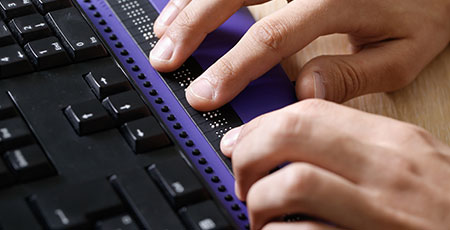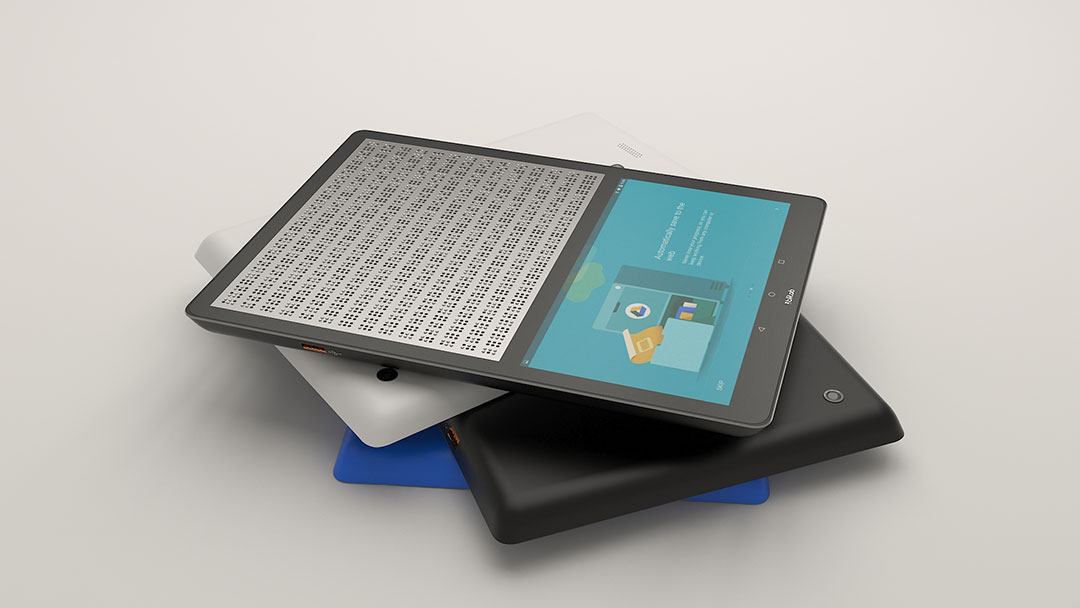Speech-to-Text Devices for Low Vision: Enhancing Accessibility
Speech-to-Text Devices for Low Vision: Enhancing Accessibility
Blog Article
Enhancing Lives With Advanced Assistive Tools for the Blind
The integration of innovative assistive devices for the blind is transforming just how individuals experience their surroundings and connect with their communities. What does this evolution imply for the future of assistive technology and its duty in empowering people?
Overview of Assistive Instruments
Assistive tools for the blind include a varied variety of technologies and devices developed to boost self-reliance and enhance the quality of life for people with visual problems. These gadgets accommodate various requirements, from navigating and flexibility to communication and daily task management.
Among the main classifications of assistive gadgets includes mobility aids, such as white walking sticks and overview pet dogs, which assist individuals browse their environments securely. Electronic travel help, geared up with sensing units and audio responses, additionally play a considerable duty in movement enhancement.
Furthermore, tools that assist with daily living tasks, such as flexible kitchen area devices, Braille labels, and chatting watches, empower individuals to do tasks separately. Interaction help, including display visitors and Braille displays, assist in accessibility to information and enable individuals to involve efficiently with the digital globe.
Additionally, low-tech remedies like magnifying glasses and large-print products continue to be important for several users. Jointly, these assistive tools offer not just as functional tools but also as essential enablers of freedom, cultivating greater engagement in a globe that frequently focuses on sighted experiences. Their integration right into every day life is important for advertising inclusivity and boosting total health for those with visual impairments.
Cutting-edge Technologies in operation
Advancement in modern technology has considerably transformed the landscape of devices readily available for individuals with visual problems. Among the most remarkable innovations are smart glasses incorporated with enhanced reality, which offer real-time navigating help and things recognition. These tools leverage progressed electronic cameras and fabricated knowledge to deliver auditory signs, boosting the user's spatial awareness and freedom.
Additionally, mobile applications have arised as powerful sources, making it possible for customers to identify currency, reviewed message aloud, and navigate unknown atmospheres through verbal guidelines. Tools such as Braille displays and refreshable Braille gadgets remain to advance, providing smooth connection with computer systems and smart devices, thus improving communication and accessibility to information.
Wearable innovation, including smartwatches geared up with voice-activated functions, further empowers individuals by promoting fast accessibility to notifications and signals without requiring aesthetic engagement. Responsive maps and 3D printing are likewise gaining traction, using substantial depictions of rooms that aid in alignment and mobility training.
Collectively, these cutting-edge modern technologies not only improve the day-to-days live of visually damaged people yet additionally foster better freedom, inclusivity, and interaction with the wider area, therefore reshaping understandings of accessibility. (Braille displays and notetakers)
Personal Stories of Empowerment
Empowerment commonly emerges from individual experiences that highlight the transformative effect of modern technology on people with aesthetic impairments. Take, for example, the tale of Sarah, a young artist that reclaimed her enthusiasm for paint through making use of a clever walking stick equipped with obstacle detection. This tool not only facilitated her movement however instilled a newly found self-confidence, enabling her to navigate public spaces independently and seek her creative ventures.

These stories highlight the extensive results that advanced assistive gadgets can have on every day life. By enabling individuals to get rid of obstacles, innovation cultivates a sense of autonomy and self-regard. Such empowerment stories function as a testimony to the capacity of technology, illustrating exactly how the right tools can significantly boost lifestyle and open doors to new opportunities for those with aesthetic impairments.
Advantages of Advanced Solutions
Just how can progressed options essentially improve the lives of individuals with aesthetic problems? The integration of sophisticated modern technology into assistive gadgets significantly changes day-to-day experiences for those influenced by vision loss. These innovative services provide unprecedented have a peek here freedom, allowing individuals to browse their settings with confidence. Instruments such as clever walking canes furnished with sensors, navigation apps, and wearable technology are designed to supply real-time feedback, boosting spatial awareness and minimizing the threats connected with flexibility.
Additionally, advanced assistive modern technologies cultivate social addition by promoting interaction and communication. Voice-activated devices and applications enable individuals to access details and involve with their environments individually, breaking obstacles that previously hindered their participation in educational, specialist, and social setups.
Furthermore, the personalization and flexibility of these services accommodate the diverse demands of users, thereby boosting their overall high quality of life. Boosted functionality, such as item recognition and text-to-speech capacities, empowers individuals with visual impairments to execute tasks that they might have when discovered challenging. Ultimately, advanced assistive modern technologies not just enhance self-reliance and security but also advertise self-respect and self-worth, enabling users to lead fulfilling lives.
Future Fads in Assistive Technology
As modern technology remains to develop, the landscape of assistive devices for the blind is positioned for remarkable innovations that will certainly additionally improve ease of access and freedom. Arising trends in assistive innovation indicate a change towards raised assimilation of synthetic knowledge (AI) and artificial intelligence, allowing tools to adapt to private customer requires in real-time. These advancements are anticipated to help with more user-friendly navigating systems that can recognize view it challenges and supply audio comments, considerably enhancing outdoor mobility.
Furthermore, the growth of wearable tech, such as smart glasses geared up with increased truth, will permit individuals to receive contextual info regarding their surroundings, thus improving their spatial awareness. In addition, advancements in haptic innovation pledge to create tactile comments devices, enabling users to regard info through touch, enhancing understanding and interaction with their atmosphere.
Telecommunication advances are additionally paving the method for remote help services, where skilled professionals can supply support using video clip telephone calls, ensuring support is easily obtainable. As these patterns unravel, the future of assistive gadgets for the blind will unquestionably foster greater autonomy, equipping people to browse their world with confidence and simplicity.

Verdict
The assimilation of sophisticated assistive devices for the blind stands for a considerable improvement in fostering self-reliance and improving quality of life. By using ingenious technologies, these devices empower users to browse their atmospheres with better confidence and freedom. As the field remains to advance, ongoing r & d will likely produce much more innovative remedies, additionally transforming the lived experiences of individuals with aesthetic impairments and advertising a better sense of incorporation within society.
The assimilation of sophisticated assistive gadgets for the blind is changing just how individuals experience their environments and connect with their areas. The combination of innovative modern technology into assistive gadgets significantly changes day-to-day experiences for those impacted by vision loss.As technology proceeds to evolve, the landscape of assistive devices for the blind is poised for amazing innovations that will certainly additionally boost ease of access and freedom. Emerging patterns in assistive technology show a change towards boosted assimilation of artificial intelligence (AI) and maker understanding, allowing devices to adapt to individual user needs in real-time.The assimilation of advanced assistive gadgets for the blind represents a significant improvement in promoting self-reliance and enhancing quality of life.
Report this page